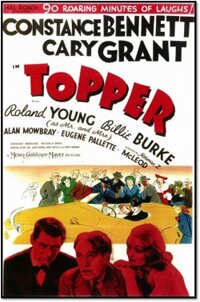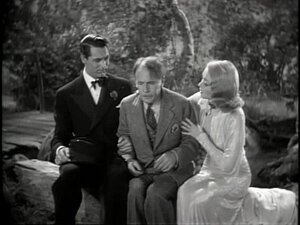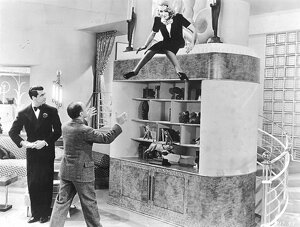Some movies leave you scratching your head, like Christmas in Connecticut. You like it yet it bugs you. Why is that?
This is another one of those movies I saw years ago as a kid watching TV in the basement. The DVD came out in 2005 and I recall watching it then but feeling ambivalent about it. I suppose I still do, though I liked it much more when I watched it last night. But that opening …
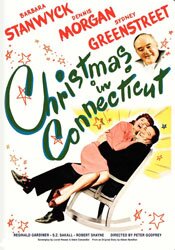 Christmas in Connecticut (1945)
Christmas in Connecticut (1945)
Directed by Peter Godfrey
This movie is an odd duck. It’s a good, quick paced Christmas movie of the old Hollywood variety, as in circa the 1940s (which is when it was made). Christmas in Connecticut has all the appearance of what we usually mean by a holiday classic. But it has some peculiarities and they are probably the reason it doesn’t quite achieve that status – though it comes close.
The first and most pronounced peculiarity is its opening. The first twenty or thirty minutes of the film are completely unnecessary and also suggest a different movie than the one we end up seeing. The movie is also a lot more interesting once that opening is over.
For some reason, perhaps length or a script change elsewhere in the film, the opening appears to be tacked on to what seems like a finished movie. Jefferson Jones, played by Dennis Morgan, is a war veteran in a hospital having survived being adrift at sea. He’s absolutely obsessed with food. This sort of sets up the movie that follows, except once that movie starts his food obsession seems to mysteriously vanish.
Food is at the heart of this romantic-comedy in the sense that it is one of the defining characteristics of Barbara Stanwyck’s character, Elizabeth Lee. She’s a kind of war time Martha Stewart, a famous master of country kitchens and homes, known as the world’s best cook. She writes for a magazine about her beautiful country home and describes the fabulous foods she prepares.
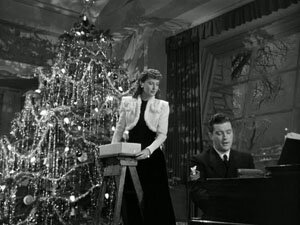 Except she’s a city apartment dweller and doesn’t know the first thing about cooking. The complication comes when her publisher, Sydney Greenstreet as Alexander Yardley, decides to invite himself and the war hero to Christmas at her home.
Except she’s a city apartment dweller and doesn’t know the first thing about cooking. The complication comes when her publisher, Sydney Greenstreet as Alexander Yardley, decides to invite himself and the war hero to Christmas at her home.
Chaos follows. There are also numerous complications, not the least of which is the need to have a husband and baby because Elizabeth Lee writes about them all the time.
It’s also quite funny, especially when Greenstreet’s Yardley sees one baby on one day and another on the next and can’t understand why it looks different, has a gender change, suddenly has teeth and can talk. “Most peculiar,” he says.
The romantic aspect is with Stanwyck’s character agreeing to marry her insistent fiancé (whom she doesn’t love) in return for providing her with a Connecticut country home to use to fool Yardley. The romance comes in when she falls in love with Jefferson, the war hero.
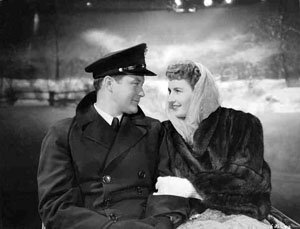 I also found some of the characterizations in the movie a bit peculiar, though not necessarily in a bad way. They just seemed odd. As mentioned, there is a food obsessed war hero who seems to forget his obsession once the real movie starts. Then there is Stanwyck’s Elizabeth Lee who appears to be completely self-centred and indulgent – yet we like her.
I also found some of the characterizations in the movie a bit peculiar, though not necessarily in a bad way. They just seemed odd. As mentioned, there is a food obsessed war hero who seems to forget his obsession once the real movie starts. Then there is Stanwyck’s Elizabeth Lee who appears to be completely self-centred and indulgent – yet we like her.
Despite the quibbles, I really did like this movie, especially once that opening was over. It certainly has the look and feel of a Hollywood holiday classic. It’s also funny and, in its Hollywood way, romantic. It gets great supporting performances, particularly those of Greenstreet, S.Z. Sakall (as the real food master) and Una O’Connor with her thick Irish accent and wonderful reactions.
For me, this movie played well – quick, engaging and almost, but not quite, satisfying. Had a bit of time been taken editing the opening, I would say it would be up there with the great holiday movies.
And I’m darned curious about how that opening came about.
On Amazon:
- Christmas in Connecticut (1945) — Video on Demand
- Christmas in Connecticut (1945) — DVD — Amazon.com (U.S.)
- Christmas in Connecticut (1945) — DVD — Amazon.ca (Canada)

